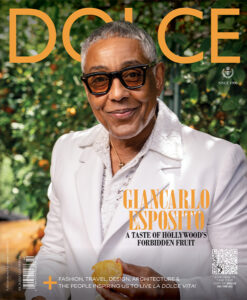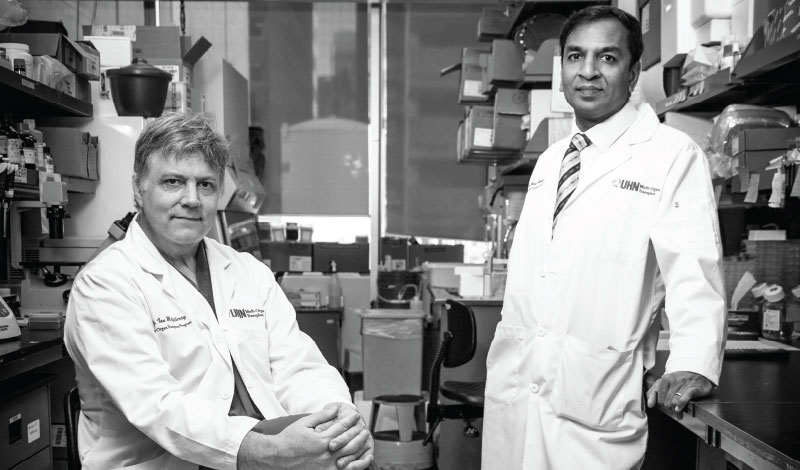The Transformative Power of Transplantation
Two doctors at the forefront of the nation’s advancements in transplantation are sharing what it takes to pursue innovation; and why organ donation is a vital component.
Toronto is on track to become a global leader in organ transplantation and research, and it’s all thanks to dedicated doctors like Dr. Atul Humar and Dr. Ian McGilvray. These driven doctors are the faces behind the Multi-Organ Transplant Program at the University Health Network (UHN), each giving his heart and soul to improving the transplantation process and outcome for the more than 600 transplants per year performed at Toronto General Hospital and the several thousand patients across Canada in their care. “We’re the largest transplant program in North America, and I guarantee you many people don’t know that,” says Dr. McGilvray. “If you look at the size of our program from a personnel perspective, we’re relatively small, but if you look at what we produce, we eclipse virtually every other program.”
This year, more than 1,000 transplants have been performed in Ontario alone. As impressive as that may be, there is still nearly double that number of patients awaiting a transplant at this very moment. These numbers are what drive Drs. Humar and McGilvray to do what they do every single day.
Transplantation was not a field that Dr. Humar really considered until he attended medical school and completed his residency. It was then that he saw the way lives were absolutely transformed after a transplant, and the young doctor was drawn to the cause. “Patients who were either on death’s doorstep from end-stage liver or lung disease or those who had been on dialysis for years with a very poor quality of life would have their lives transformed,” says Dr. Humar. It was not only the patients, but also their families whose hopes and lives were restored.
Today, as the medical director of the program at UHN, Dr. Humar has his hands in every single aspect of the process. From research to administration to patient care, his role is to ensure that the talented team of physicians, researchers and nurses are equipped with the resources they need to be the very best at what they do. “I’m very much involved in trying to make sure that we have the best organ transplant program in the world right here in Toronto,” says Dr. Humar. “And to do that, not only do we have to have a very large program with excellent patient outcomes, but also we really need to be at the leading forefront of research in all areas of transplantation.”
According to Dr. Humar, this includes looking at alternatives to organ transplant like stem-cell therapy, and it also involves researching ways to prevent rejection of organs and infection. Not many people know that Toronto is home to one of the few multidisciplinary labs looking specifically at how infections in transplantations occur and how they can be prevented. For Dr. Humar, this is another crucial component to the success of the transplant program.
What’s more, Dr. Humar is lucky enough to run the lab with another dedicated researcher, Dr. Deepali Kumar — his wife. “It’s great, we can always bounce ideas off each other, and I think it’s been pretty helpful in driving our research forward,” says Dr. Humar.
It’s shocking to know that while many of us may believe organ donation is important, less than a third of Ontarians (about 32 per cent) are actually registered donors. Dr. Humar agrees that this is largely due to the common misconception that a doctor will “pull the plug” on a patient if they have declared themselves to be an organ donor. This is false. In Canada, the processes of death, organ donation and organ transplantation are always handled separately. “We’re not involved in the donation process whatsoever,” says Dr. Humar.
Coupling industry-leading research with award-winning technology, Dr. McGilvray, research director of the program at UHN, has spearheaded an immersive online experience called the Toronto Video Atlas of Liver, Pancreas and Transplant Surgery. This initiative is in addition to his role co-directing the Toronto Liver Laboratory. The Atlas was designed to instruct surgeons about the care of patients with problems in liver, pancreas and transplant surgery and to highlight the advanced surgical techniques required for the management of these diseases.
The tool features a number of resources, including standard to complex cases and surgical techniques. A portion of the website allows physicians to refer transplant patients to the resource for a collection of patient- and family-specific 3D computer animations that explain common liver, pancreas and transplant surgeries performed at Toronto General Hospital. Animations give an overview of steps in the procedure, the possible risks and complications of the surgery, as well as post-operative care and discharge information.
“If you look at the size of our program from a personnel perspective, we’re relatively small, but if you look at what weproduce, we eclipse virtually every other program”
Dr. McGilvray admits that oftentimes patients are not given a great deal of time with their doctor in the interview room, so something like the patient education module is good because it tells a story. “A patient and their family can run it through as many times as they’d like. It’s a condensed version of the sort of things I would say in the clinic and it’s always there.”
The Atlas is the byproduct of the collaborative efforts of a group of expert surgeons and biomedical communicators and has won numerous accolades. The website earns a minimum of 500 to 600 hits per day.
Dr. McGilvray is enthusiastic for the future of transplantation and for the possible game-changing innovations and discoveries to come. “I think the future of transplantation is not even necessarily in transplantation. I think the future of transplantation is the understanding of the organs of transplantation,” says Dr. McGilvray. “I think that if we get to a point of understanding an organ well enough, we can grow it outside of the body, or create it outside of the body, or come up with models that are based on the human starting point. Then we can change disease, period, because for the first time we’ll have an understanding of what the human condition is.”
One organ and tissue donor can save up to 8 lives and improve life for up to 75 others.
He also shares that the team is moving into mixed reality and virtual reality. “The animation and modelling stuff is extremely useful from an educational standpoint, but virtual reality is another level altogether,” says Dr. McGilvray. “We can create a virtual operating room very quickly, or a virtual person, or a virtual teaching module, and it’s extraordinarily immersive. It’s a bit frightening in some ways. You no longer require person-to-person contact; you can create the whole thing in an artificial world.”
Dr. McGilvray admits that it’s a compelling world, one full of opportunity and possible advancements in the field, but it all begins with donors —financial and organ pledges — which will allow Drs. Humar and McGilvray to continue their life-changing work in transplantation.
To make a donation to UHN’s Transplant Program, visit www.uhnliveon.ca.
uhn.ca/MOT
pie.med.utoronto.ca/TVASurg/





















































































No Comment